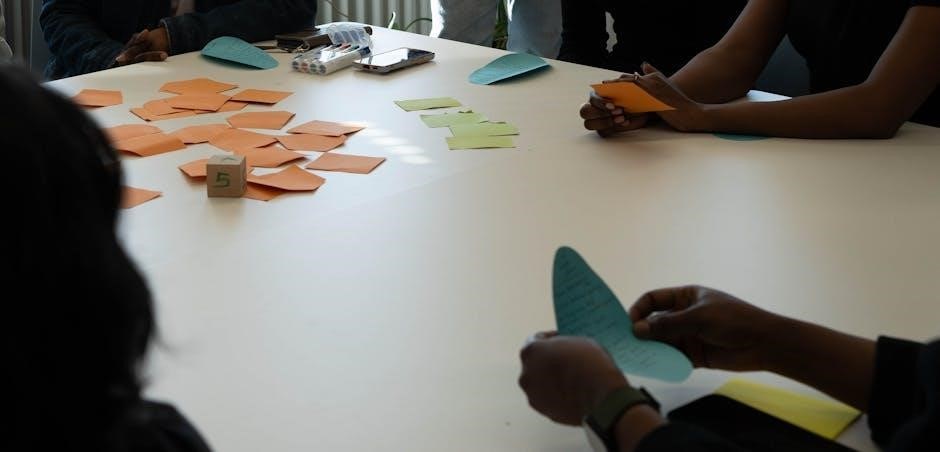situation-problème 6e année pdf
A situation-problème is a problem-solving tool that introduces new concepts through real-life scenarios, encouraging critical thinking and collaboration. It is widely used in math, French, and other subjects.
Overview of the Concept
A situation-problème is an educational tool designed to engage students by presenting real-life scenarios that require problem-solving skills. It introduces new concepts through practical applications, fostering critical thinking and collaboration. This approach is particularly effective in subjects like math, French, and language arts, where students can apply theoretical knowledge to resolve everyday challenges. The concept emphasizes interdisciplinary learning, making it a versatile method for 6th-grade curriculum integration. Its structure encourages students to explore, analyze, and find creative solutions to problems.

Definition and Purpose of Situation-Problème
A situation-problème is a problem-solving tool that introduces new concepts through real-life scenarios, encouraging critical thinking and collaboration. Its purpose is to engage students in meaningful learning experiences.
What is a Situation-Problème?
A situation-problème is a problem-solving scenario that presents a real-life situation to introduce new concepts. It encourages critical thinking, collaboration, and problem-solving skills. Students are guided to apply mathematical or linguistic knowledge to resolve the issue. For example, in math, Louis reading his dictionary illustrates how such problems are structured, requiring students to calculate the number of days needed to finish the book. This approach fosters deeper understanding and practical application of skills.
The Purpose of Situation-Problème
The purpose of a situation-problème is to introduce new concepts through real-life scenarios, fostering critical thinking and problem-solving skills. It encourages students to apply knowledge across subjects like math and French. By presenting relatable challenges, such as managing a dog shelter, it prepares students to tackle complex issues collaboratively. This approach enhances understanding, creativity, and logical reasoning, making learning engaging and meaningful for 6th-grade students.
Key Characteristics of Situation-Problème
Situation-problème introduces new concepts through real-life scenarios, involving problem-solving and critical thinking. It is applied across subjects like math and French, fostering collaboration and deeper understanding.
Structure and Components
A situation-problème is structured around real-life scenarios that introduce new concepts through problem-solving. It typically involves a narrative or context that requires critical thinking and collaboration. Students are presented with a challenge or question that encourages them to apply what they have learned. The problem often includes multiple steps or components, such as decoding information, analyzing data, and proposing solutions. This approach fosters engagement and deeper understanding by connecting abstract concepts to relatable situations.
Relevance to 6th-Grade Curriculum
The situation-problème is highly relevant to the 6th-grade curriculum as it aligns with learning objectives that emphasize critical thinking, problem-solving, and collaboration. It engages students by connecting abstract concepts to real-life scenarios, making learning more interactive and meaningful. This approach is particularly effective in math, French, and interdisciplinary subjects, where students can apply their knowledge to practical challenges. The curriculum’s focus on developing reasoning and communication skills makes situation-problème a valuable educational tool for this age group.
Examples of Situation-Problème in Math
Louis has a dictionary with 1,526 pages. If he reads two pages daily, how many days will it take to finish? This problem introduces division concepts.
Math Problem Examples
In math, situation-problème involves real-life scenarios to develop problem-solving skills. For instance, Louis has a dictionary with 1,526 pages and reads two pages daily. Students calculate how many days it will take him to finish. Another example: there are three 6th-grade classes at école Anne-Hébert with 30, 26, and 22 students respectively. Pupils practice subtraction and addition to find the total number of students. These problems introduce new concepts like division and multi-digit addition, fostering critical thinking and collaboration among students.
Case Study: Louis and the Dictionary
Louis’s dictionary has 1,526 pages, and he reads two pages daily. Students calculate how many days it will take him to finish. This situation-problème introduces division and multi-digit subtraction, encouraging critical thinking. It also fosters collaboration as students discuss methods to verify their answers. Such real-world problems help students apply mathematical concepts to everyday situations, making learning engaging and meaningful while developing problem-solving skills.
Applications in French and Language Arts
Situation-problème in French class involves solving linguistic challenges, like grammar or spelling errors, within a story. It enhances oral and written communication skills through engaging, real-life scenarios.
French Language Situation-Problèmes
Situation-problème in French language arts involves creating engaging scenarios that challenge students to solve linguistic problems. For example, in “The Curious Characters in the Neighborhood,” students encounter two video game characters who love to eat and must resolve grammar, spelling, or vocabulary issues to progress. Such exercises enhance critical thinking, oral, and written communication skills, making language learning interactive and enjoyable for 6th graders.
Case Study: The Curious Characters in the Neighborhood
This case study introduces two video game characters who disrupt a neighborhood by eating various objects. Students must use French language skills to solve problems, such as correcting grammar and spelling errors in dialogues or creating stories. Activities focus on oral and written communication, fostering creativity while reinforcing linguistic concepts. The scenario engages learners by blending humor and real-life challenges, making language acquisition dynamic and fun for 6th graders.

Situation-Problème in Other Subjects
Situation-problème extends beyond math and French, applying to science, history, and language arts. It engages students in solving real-world problems, fostering interdisciplinary learning and critical thinking skills effectively.
Interdisciplinary Applications
Situation-problème is a versatile tool that extends into various subjects like science, history, and language arts. It encourages students to apply mathematical reasoning to real-world dilemmas, such as managing resources for a dog shelter or solving environmental challenges. By integrating multiple disciplines, it fosters a deeper understanding of complex issues. For example, a problem involving a dog shelter might combine math, biology, and ethics, promoting critical thinking and collaboration. This approach prepares students to tackle diverse, interconnected challenges in their future studies and careers.
Case Study: The Dog Shelter Situation
A situation-problème involving a dog shelter challenges students to manage resources effectively. The shelter has limited food and space, and students must calculate how to accommodate more dogs while ensuring fair distribution of resources. This problem integrates math, ethics, and biology, encouraging students to think critically about real-world dilemmas. By solving this, they develop problem-solving skills and understand the importance of resource management in community contexts.

Resources and Activities for Teachers
Teachers can access guides, correction tools, and interactive exercises for situation-problème. Resources like “Les irréductibles” and “madame Nancy’s activities” support lesson planning and student engagement effectively.
Available Resources
Teachers can utilize guides like Les irréductibles and interactive tools from madame Nancy’s resources for creating engaging situation-problème activities. These resources provide structured exercises, correction aids, and thematic problem sets tailored for 6th-grade students. They cover various subjects, including math, French, and interdisciplinary topics, ensuring comprehensive coverage. Additionally, websites offer corrigés and préparations to help teachers design effective lessons and assessments. These materials are adaptable for different learning needs, making them invaluable for classroom implementation.
Activities and Exercises
Engaging situation-problème activities for 6th graders include interactive math problems, French language exercises, and interdisciplinary case studies. Students solve real-life scenarios, such as Louis and the Dictionary, to practice problem-solving. Exercises like Les irréductibles offer structured tasks with corrections, while thematic problem sets cover grammar, orthography, and oral skills. These activities encourage critical thinking, collaboration, and practical application of concepts, preparing students for diverse challenges in math, language, and beyond.

Evaluation and Assessment
Evaluation involves observing students’ problem-solving skills, collaboration, and concept understanding. Assessments include reviewing solutions to situation-problème tasks and group work, ensuring comprehensive skill measurement.
Methods of Evaluation
Evaluation of situation-problème involves assessing problem-solving skills, collaboration, and understanding. Teachers use formative assessments to monitor progress during activities. Peer evaluations encourage critical thinking and self-assessment. Rubrics provide clear criteria for grading, ensuring fairness and transparency in measuring student performance and concept mastery.
Case Study: School Anne-Hébert
École primaire Anne-Hébert implements situation-problème effectively in its curriculum. With three 6th-grade classes, the school demonstrates problem-solving through real-world math challenges. For example, the first class has 30 students, the second has 4 fewer, and the third has 6 fewer. Students calculate total class sizes and compare differences, fostering reasoning and collaboration. This approach aligns with interdisciplinary learning, preparing students for complex, practical scenarios.
Situation-problème is a problem-solving approach that introduces new concepts through real-life scenarios, fostering critical thinking and collaboration. It is applied across subjects like math, French, and language arts, using case studies such as Louis and the Dictionary or The Curious Characters in the Neighborhood. Resources like exercises, activities, and evaluation tools support teachers in implementing this method. By connecting abstract concepts to practical situations, situation-problème helps students apply learning to real-world challenges, enhancing their understanding and problem-solving skills effectively.
